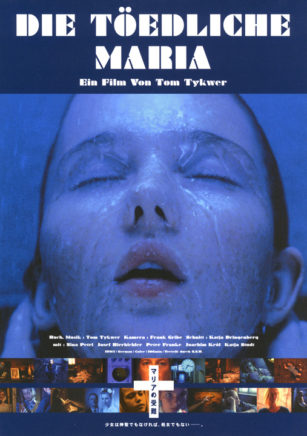 The first feature by Tom Tykwer was this stunningly lensed 1993 exercise in surreal oppression. It’s quite grim, but also absorbing, thought-provoking and deserving of wider exposure. Although DEADLY MARIA (DIE TODLICHE MARIA) received a fair amount of film festival exposure during the early nineties, it’s largely vanished from circulation. Thus far the film’s only appearances on home video were via an out-of-print German VHS and a Japanese DVD.
The first feature by Tom Tykwer was this stunningly lensed 1993 exercise in surreal oppression. It’s quite grim, but also absorbing, thought-provoking and deserving of wider exposure. Although DEADLY MARIA (DIE TODLICHE MARIA) received a fair amount of film festival exposure during the early nineties, it’s largely vanished from circulation. Thus far the film’s only appearances on home video were via an out-of-print German VHS and a Japanese DVD.
It is, however, one of Tom Tykwer’s finest films, indeed perhaps the finest, playing intriguingly on quite a few motifs he’s explored in subsequent projects like RUN LOLA RUN (1998), THE PRINCESS AND THE WARRIOR (2000) and HEAVEN (2002). Of course DEADLY MARIA is also Tykwer’s darkest film, and appears to have turned off many American critics and film buffs.
The mousy Maria is living a Hellish existence in a vast, nightmarish townhouse lorded over by her infirm father and inattentive husband. When not tending to the men’s needs Maria writes letters to herself and hides money inside a phallic statue (in anticipation of an escape from her unacceptable reality). She becomes drawn to Dieter, an eccentric man living in the downstairs apartment across the street; the two strike up a tentative romance, but it’s strictly a case of too little-too late, as Maria’s ultimate path is a grim and violent one.
It takes a look back over Maria’s life—as a child she was forced into a subservient role, and later an arranged marriage to her father’s best friend—to fully bring her demons to light. A creepy dream follows involving Maria giving birth to a slimy something that evolves into a deadlier and more assertive Maria.
This new Maria wastes no time killing off her husband, and in suitably gruesome fashion. This leaves her a delusional basket case. Her father is clearly the next victim in line for Deadly Maria, but what about Dieter? Will he and Maria live happily ever after or is he to become another of her victims?
DEADLY MARIA, with its assured and impressive craftsmanship, must be counted as among the most impressive filmmaking debuts of the nineties. Tom Tykwer, working with the skilled cinematographer Frank Griebe (who shot all Tykwer’s subsequent films), incorporates all manner of stylistic quirks—innumerable dissolves and superimpositions, excessively bright colors, slow motion, overlapping dialogue, inanimate object POV shots, 360 degree pans, David Lynchian dream sequences—but the film never feels the least bit chaotic or disjointed. It has a smooth, confident flow, imparting a real sense of mounting desperation engendered by its all-too convincing depiction of Maria’s unquiet mind. Tykwer also proves himself a skilled director of actors, with Nina Petri (who also appeared in RUN LOLA RUN) delivering a couldn’t-be-better performance in the title role.
The final scene, featuring a semi-impressionistic flight of fancy (a Tykwer trademark), works, but isn’t all it could be. Apparently Tykwer had a far more extravagant ending in mind but was stymied by lack of funds. That’s a shame. It’s also a shame that DEADLY MARIA has become so obscure, because if ever a film was in dire need of a rediscovery it’s this one.
Vital Statistics
DEALDY MARIA (DIE TODLICHE MARIA)
Liebesfilm
Director: Tom Tykwer
Producers: Stefan Arndt, Tom Tykwer
Screenplay: Tom Tykwer
Cinematography: Frank Griebe
Editing: Katja Dringenberg
Cast: Nina Petri, Katja Studt, Juliane Heinemann, Josef Bierbichler, Peter Franke, Jean Maeser, Joachim Krol, Rolf Peter Kahl, Renate Usko, Georg Winterfeld, Tom Spiess, Andreas Petri, Nada Daniels
